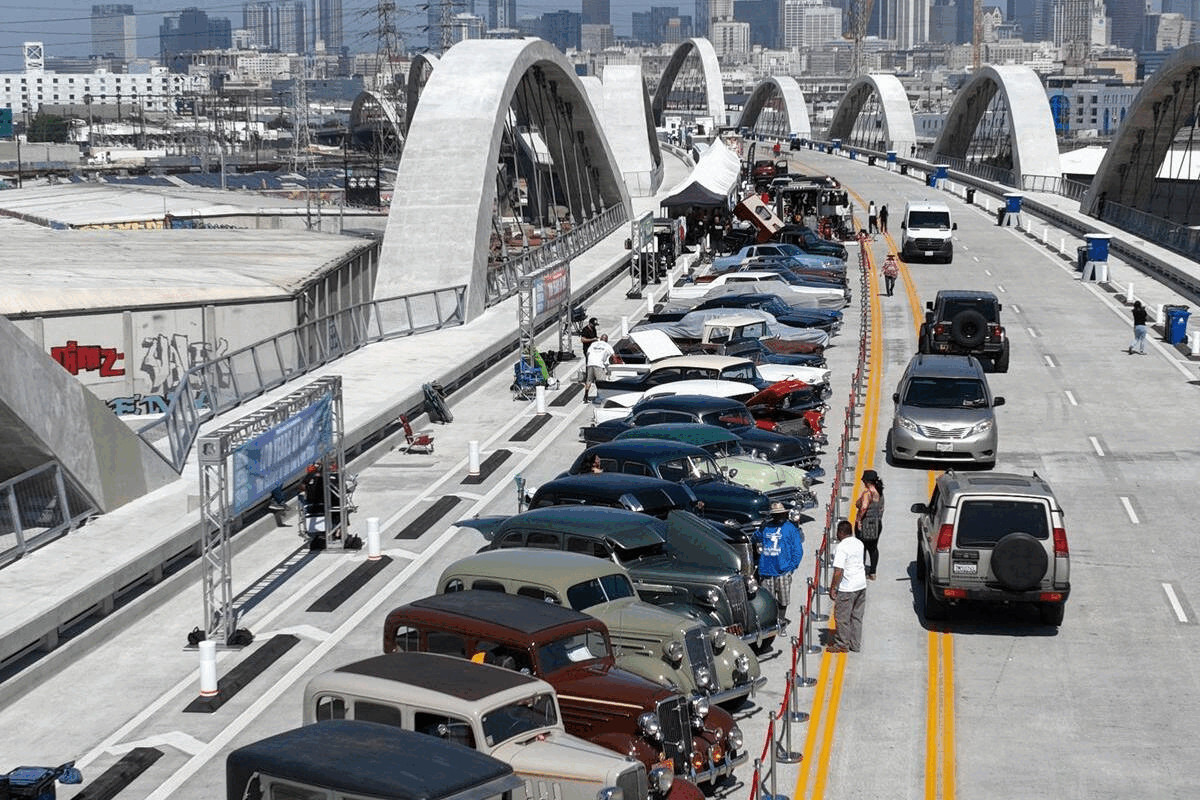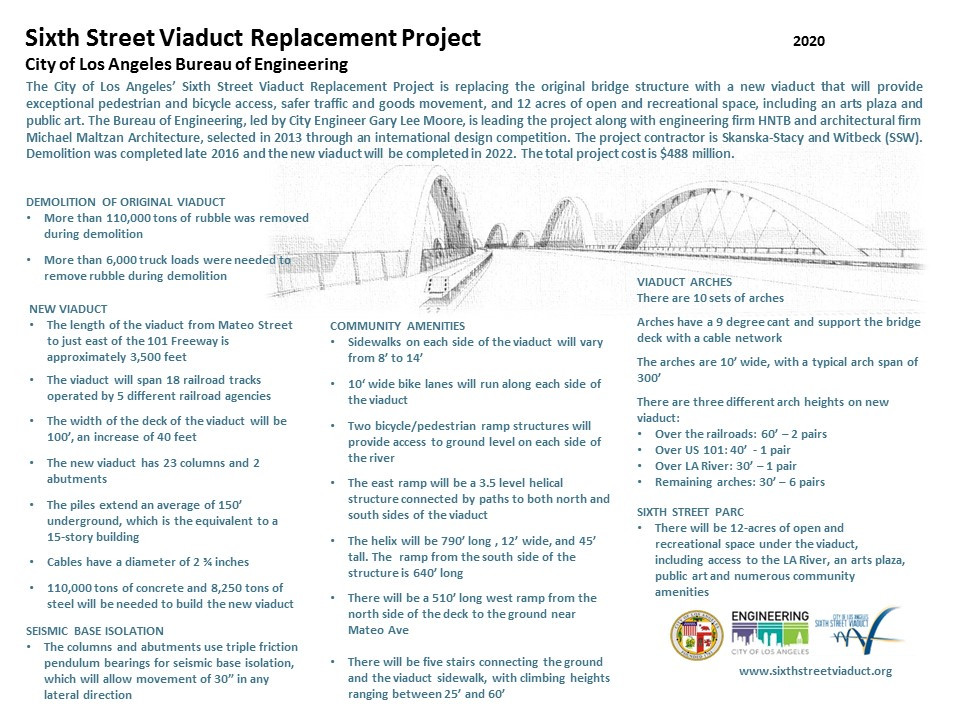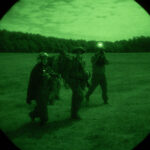Los Angeles unveiled a gleaming new landmark in July 2022, the Sixth Street Viaduct, a $588 million project by the City of Los Angeles Bureau of Engineering. This ambitious undertaking replaced the original 1932 bridge, marking the largest bridge project in the city’s history. More than just a functional structure, the new viaduct, dubbed “The Ribbon of Light,” is set to become a defining feature of the LA cityscape.
From Deterioration to Design Competition: The Genesis of the New Viaduct
The original Sixth Street Bridge, a beloved structure from 1932, had succumbed to Alkali Silica Reaction, a condition causing concrete to crack due to moisture absorption. Despite numerous attempts to repair and reinforce the aging bridge, engineers concluded that replacement was the only viable solution.
The City of Los Angeles Bureau of Engineering initiated a global design competition in 2012, seeking innovative concepts for the replacement. Local firm Michael Maltzan Architects, in collaboration with HNTB, emerged as the winners with their visionary “Ribbon of Light” design. Community engagement was central to the process, ensuring the new bridge reflected the needs and aspirations of the surrounding neighborhoods.
Demolition of the old bridge commenced in 2016 and lasted nine months. Following the removal, construction of the new viaduct began, transforming the landscape over several years. The project was a collaborative effort, financially supported by the Federal Highway Administration, the California Department of Transportation, and the City of Los Angeles.
 Aerial view of the Sixth Street Viaduct Grand Opening celebration with crowds of people walking and biking across the bridge.
Aerial view of the Sixth Street Viaduct Grand Opening celebration with crowds of people walking and biking across the bridge.
A Bridge for the Future: Features of the Sixth Street Viaduct
The new Sixth Street Viaduct is more than just a bridge; it’s a multi-faceted public space designed for pedestrians, cyclists, and vehicles alike. Its most striking feature is the ten pairs of illuminated arches, equipped with color-changing LEDs, promising a dynamic visual spectacle, especially at night.
Beyond aesthetics, the viaduct boasts practical enhancements:
- Pedestrian-Friendly Sidewalks: Generous sidewalks, ranging from 8 to 14 feet wide on each side, encourage walking and offer stunning city views.
- Protected Bike Lanes: Dedicated 10-foot wide Class IV protected bike lanes on both sides promote cycling as a safe and enjoyable mode of transport.
- Helical Ramps: An elaborate 3.5-level helical ramp on the Boyle Heights side provides access, stretching 790 feet long, 12 feet wide, and reaching 45 feet in height, connecting both north and south sides of the viaduct.
- West Ramp Access: A 510-foot west ramp on the north side provides ground-level access near Mateo Street.
- Future Park Access: Five sets of stairs are integrated into the design, leading to the ground below, which will connect to the forthcoming Sixth Street Viaduct PARC, slated for completion in 2026.
These features transform the Sixth Street Viaduct into a vibrant public space, enhancing connectivity and offering recreational opportunities for Los Angeles residents and visitors.
Honoring the Past: The Legacy of the Original Sixth Street Bridge
The original Sixth Street Viaduct, constructed in 1932, was a vital piece of Los Angeles infrastructure and a celebrated engineering achievement. As the longest of the fourteen historic bridges spanning the Los Angeles River, it was a critical link between the Arts District and Boyle Heights.
The bridge’s gritty urban aesthetic made it a popular filming location, featured in numerous movies, music videos, and commercials, often depicting quintessential LA car chases. Spanning 3,500 feet, it accommodated four lanes of traffic and sidewalks.
Uniquely, the original viaduct was built using an on-site concrete mixing plant due to its immense scale. However, the aggregate used in the concrete unfortunately contained reactive silica, leading to Alkali Silica Reaction and structural deterioration within just two decades.
Despite continuous and costly repair efforts, the damage persisted. Seismic studies revealed a high vulnerability to earthquake damage, coupled with design and safety shortcomings, ultimately necessitating its replacement.
The Sixth Street Viaduct Replacement Project: A Monumental Undertaking
Under the leadership of City Engineer Gary Lee Moore, the Bureau of Engineering spearheaded the Sixth Street Viaduct Replacement Project. This $588 million venture represents the largest bridge project in Los Angeles history, funded through a combination of federal, state, and city resources.
The “Ribbon of Light” design, a collaboration between HNTB and Los Angeles architect Michael Maltzan, was selected through an international competition, emphasizing innovative aesthetics and functionality. Skanska Stacy and Witbeck led the construction, bringing the ambitious design to life.
The project generated numerous jobs, providing a significant economic boost to central Los Angeles and its surrounding communities. The new viaduct stands as a testament to modern engineering and urban planning, poised to serve Los Angeles for generations to come.
 Design Fact Sheet graphic showing elevations and sections of the Sixth Street Viaduct with dimensions and labels for various structural components.
Design Fact Sheet graphic showing elevations and sections of the Sixth Street Viaduct with dimensions and labels for various structural components.
Community Collaboration: Shaping the Viaduct’s Design
Community input was integral to the design process of the new Sixth Street Viaduct. Two committees, the Design Aesthetic Advisory Committee (DAAC) and the Community Advisory Committee (CAC), played crucial roles in shaping the project.
The DAAC, comprised of community leaders and professionals appointed by the Mayor, provided guidance on the bridge’s aesthetic elements, surrounding roadways, lighting, and monumental features. Their expertise ensured the bridge’s design resonated with the city’s artistic and cultural landscape.
The CAC, consisting of diverse community stakeholders, advised the Bureau of Engineering during the Environmental Impact Report and planning phases. This committee addressed community concerns, fostered public involvement, and contributed to developing community ownership and consensus on the bridge’s design, recreational aspects, and safety features.
Illuminating the Cityscape: The Arches of the 6th Street Bridge
The ten pairs of arches are a defining architectural element of the new Sixth Street Viaduct. These arches, canted outwards at a 9-degree angle, support the bridge deck through an intricate cable network. The robust cables measure 2 ¾ inches in diameter, and each arch is 10 feet wide, with a typical span of 300 feet.
The viaduct incorporates varying arch heights to accommodate different infrastructural elements:
- 60-foot Arches: Two pairs span over railroad tracks.
- 40-foot Arch: A single pair gracefully arches over US 101.
- 30-foot Arches: The remaining seven pairs complete the iconic rhythmic design.
These arches are not only structural marvels but also serve as canvases for dynamic LED lighting, enhancing the bridge’s visual appeal and making it a prominent feature of the Los Angeles skyline, day and night.
 Diagram of the Sixth Street Viaduct showing key dimensions, arch locations, ramp structures, and overall layout of the bridge in relation to the Los Angeles River and surrounding areas.
Diagram of the Sixth Street Viaduct showing key dimensions, arch locations, ramp structures, and overall layout of the bridge in relation to the Los Angeles River and surrounding areas.
Documenting the Transformation: “Bridging Los Angeles”
The Bureau of Engineering produced a documentary film, “Bridging Los Angeles,” which premiered in January 2016. This film chronicles the history of the Sixth Street Viaduct and other historic bridges along the Los Angeles River, offering valuable insight into the city’s infrastructural heritage and the complexities of the replacement project.
The documentary is available for viewing here, providing a deeper appreciation for the vision and effort behind the new Sixth Street Viaduct.
Filming on the Sixth Street Viaduct: Capturing LA’s New Icon
The Sixth Street Viaduct, with its striking design and panoramic views, is poised to become a sought-after filming location. All filming inquiries should be directed to FilmLA, the official film permit agency for the City of Los Angeles. Contact FilmLA at 213-977-8600 or visit their website: http://www.filmla.com/getting_started.php.
The new Sixth Street Bridge is more than just a replacement; it’s a reimagining of a vital Los Angeles landmark, designed for the 21st century and beyond. It stands as a symbol of innovation, community collaboration, and the enduring spirit of Los Angeles.

